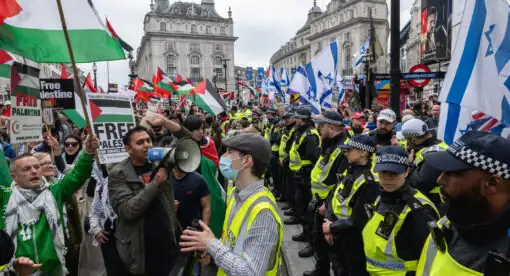The events in the past 10 days involving Iran (the Soleimani killing, Iran’s retaliatory strikes, the downing of the Ukrainian airliner, and the eruption of angry protests) need to be considered in the form of a net assessment on the Islamic Republic’s current strategic position. These four developments underscore a key trend that’s been in the making for some time now: Iran’s influence in the Middle East is no longer expanding. In fact, it is safe to say that the clerical regime, which is due to turn 41 next month, is geopolitically stagnating. The Trump administration must factor this in as it continues to deal with a Tehran under pressure.
The Chain of Events
Policy circles erupted with predictions of doom and gloom in the wake of the Jan 3 killing of Soleimani in a U.S. drone strike. Many argued that it would lead to a major conflict with Iran. Alarmist predictions aside, any retaliation from Tehran requires some time and thinking to mount. However, the Iranians needed a placeholder move until then, which explains the carefully managed missile strikes on Iraqi bases housing U.S. military personnel – designed to not cause any American casualties.
The Iranian leadership tried to use the international criticism of Washington’s decision to eliminate the commander of the Islamic Revolutionary Guards Corps’ (IRGC) Quds Force. Tehran sought to leverage Soleimani’s death to enhance its bargaining position with the United States. Iran’s leaders also hoped to use the killing of the head of its military’s overseas operations arm (who had been built up as a national hero) to get a better handle on domestic public unrest spurred by worsening economic conditions.
However, the plan to mount symbolic missile strikes went awry. The IRGC’s Aerospace Force personnel mistakenly shot down Ukrainian Airlines Flight 752. The ill-fated airliner had taken off from Tehran’s main airport only minutes before it was struck by an Iranian missile. All 176 aboard perished, including 138 Iranians, most of whom were returning to Canada.
This tragedy, which the Iranians were late to accept responsibility for, completely reversed the situation for the Iranian state. Tehran went from being the victim of a U.S. attack to being the perpetrator of a horrendous act. Iran has come under serious international pressure and has had to issue visas to Canadian officials who are participating in the investigation into the downing of the airliner. This is despite the fact that Tehran and Ottawa have not had diplomatic relations since 2012.
Meanwhile at home, the regime is faced with a fresh wave of angry protesters, many of whom were not involved in the ongoing demonstrations against the dire financial circumstances. These protests are not as significant but what is important is that for the first time the regime is on the defensive. The IRGC, which has been built up as the primary institution responsible for both defense against external threats and internal security, has been forced into an unprecedented situation of having to apologize. More importantly, the downing of the commercial jet has exposed the IRGC’s weakness as a professional military force.
A Long-Lived Trend
This decline in Iran’s strategic position is not a recent development. Tehran’s political economy has been sharply deteriorating since 2012, when the Obama administration imposed the most severe round of sanctions. It was those sanctions that forced the Islamic republic to begin talks that eventually led to the 2015 nuclear deal. Faltering finances made it very difficult for the regime to balance its massive foreign policy prerogatives, which Soleimani was leading, with the domestic economy.
The Iranian public has criticized the regime for expending far more resources on supporting Shiite allies in the Arab world than on Iranian citizens. The primary reason was that it had reached the limit of how far it could push on foreign policy front while avoiding domestic unrest due to a sanctions-wracked economy. It received a short respite from the sanctions regime after the 2015 nuclear agreement. Come 2017, the Trump administration nixed the deal, and Tehran once again faced limitations on the foreign policy front.
Though Iran played a key role in the survival of the Assad regime in Syria, it cannot help the regime re-establish its writ in the entire country. Likewise, Tehran was able to deeply penetrate the Iraqi state through its allied political factions and militias and helped roll back ISIS, but it has no solution for Iraq’s governance issues. Similarly, in Yemen, the Islamic Republic supported the rise of the al-Houthi rebels but only to the point where they are trapped in a stalemated civil war. In the same way, its assistance enabled Hezbollah to become a major player in Lebanon but one constantly locked in a tug-of-war with hostile factions.
In recent months, Iran’s fragile arc of influence began to break apart. Mass protests erupted in both Iraq and Lebanon, with even Shia protesting against Iran and its proxies’ failure to provide a viable political economy. Iraq and Lebanon are prime pieces of geopolitical real estate in a contiguous sphere of influence extending to the Mediterranean that Iran has been working feverishly to establish. This was the context in which Soleimani was killed and within days of his death Iran’s fortunes have gone from bad to worse.
What Lies Ahead
By no means is the Iranian regime about to crumble. However, it has long passed its peak. The scope of Tehran’s influence will ebb and flow. Because that influence is a function of Tehran’s ability to exploit a strategic weakness in the Arab world, and not its intrinsic strength.
Domestically, Iran is approaching an impasse. It cannot indefinitely rely on coercive means to contain masses whose discontent continues to rise. Iran’s regime is also undergoing an evolutionary change from within. The clerical, military, and civilian stakeholders of the Islamic Republic will need to compromise on both the international and domestic fronts in order to maintain regime continuity.
The current situation is an opportunity for the United States. The Trump administration has to do little beyond enforcing current sanctions. The sanctions regime highlights the problems of governance at home and limits the country’s ability to project power in the region where the Iranians are already facing indigenous resistance. At the same time, Washington should work with its international partners to use the current situation to get Tehran back to the negotiating table.
Dr. Kamran Bokhari is a Founding Director of the Newlines Institute. Dr. Bokhari is also the coordinator for Central Asia studies at the State Department’s Foreign Service Institute (FSI). Bokhari is also a national security and foreign policy specialist at the University of Ottawa’s Professional Development Institute. The views expressed in this article are those of the authors and are not an official policy or position of Newlines Institute, FSI, the U.S. Department of State or the University of Ottawa. Follow him on Twitter at @KamranBokhari.
Minna Jaffery is the Content Manager at Newlines Institute. Her research focuses on South Asia-Persian Gulf relations, terrorism, ideology, and U.S. national security. Ms. Jaffery obtained her MA in Middle Eastern, South Asian, and African Studies from Columbia University, and a BA in Near Eastern Languages and Civilizations and English from the University of Chicago. She has previously worked at the Center for American Progress and the Tow Center for Digital Journalism. Follow her at @MinnaAJaffery.
The views expressed in this article are those of the author and not an official policy or position of the Newlines Institute.







